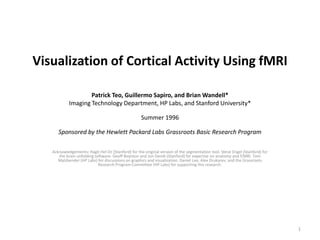
Visualization of Cortical Activity using fMRI - Summary
- 1. Visualization of Cortical Activity Using fMRI Patrick Teo, Guillermo Sapiro, and Brian Wandell* Imaging Technology Department, HP Labs, and Stanford University* Summer 1996 Sponsored by the Hewlett Packard Labs Grassroots Basic Research Program Acknowledgements: Hagit Hel-Or (Stanford) for the original version of the segmentation tool. Steve Engel (Stanford) for the brain unfolding software. Geoff Boynton and Jon Demb (Stanford) for expertise on anatomy and f/MRI. Tom Malzbender (HP Labs) for discussions on graphics and visualization. Daniel Lee, Alex Drukarev, and the Grassroots Research Program Committee (HP Labs) for supporting this research. 1
- 2. Background The goal of this summer project was to investigate and to improve existing techniques involved in the visualization of human cortical activity using functional magnetic resonance imaging (fMRI). In conventional magnetic resonance imaging (MRI), a volume of data representing the anatomical structure of the cortex is reconstructed. Functional MRI, on the other hand, indirectly measures the amount of neural activity in different regions of the cortex. Cortical activity occurs largely in the gray matter regions of the cortex. Thus, most Figure 1: MRI of the occipital pole of the left hemisphere of a human brain. visualization techniques require prior segmentation of this gray matter component. 2
- 3. Background (cont’d) Gray matter segmentation is difficult because gray matter forms only a thin (2 mm or 2 pixel) layer on the surface of the cortex, which itself is inundated with numerous ridges and folds (as shown in Figure 2). Currently, much of gray matter segmentation is performed manually. This process is tedious and requires several days even for a trained person. On the other hand, most automatic gray matter segmentation methods that have been proposed do not consider anatomical constraints and often produce segmentations that are anatomically incorrect. We propose a new semi- Figure 2: Photograph of a cross section of automatic method of gray matter an actual human cortex. segmentation that takes into consideration these anatomical requirements. 3
- 4. Method (Step 1) Our proposed method consists of four steps. In the first step, white matter is segmented. White matter is segmented because it is less noisy and suffers less from partial volume effects. Figure 3 shows the results of segmenting the white matter in Figure 1. The maximum a posteriori probability (MAP) estimate coupled with a structural prior is used to determine segmentation. The structural prior is applied using a novel technique involving anisotropic smoothing. Figure 3: Segmentation results of white matter. 4
- 5. Method (Step 2) In the second step, the white matter connected component corresponding to the cortex is selected using a 3D connected components algorithm. After this single connected component is extracted, the topology of that component is verified in the third step. Since, in the anatomy, gray matter borders on white matter, the topology of gray matter places constraints on the topology of white matter. Figure 4: Segmentation results of gray Specifically, because gray matter is a matter. sheet, the white matter component cannot have cavities or handles. Cavities are identified using a flood- filling algorithm. Handles are detected by computing the Euler characteristic of the white matter. 5
- 6. Method (Step 3) In the final step, the gray matter classification is grown out from the boundary of the white matter component (as shown in Figures 4 and 5). Since gray matter is at most 2 mm (or 2 pixel) thick in this direction, only two layers of gray matter classification are grown. Connectivity between gray matter voxels are determined from the connectivity of their parents from which they were grown. Thus, gray matter voxels may be adjacent in the volume but not connected on the gray matter surface. Figure 5: Segmentation results of gray matter overlaid on original MR image. 6
- 7. Conclusions Manual segmentation of the occipital pole of the left hemisphere (less than one eighth of the cortex) takes about 18 hours typically while the semi- automatic procedure proposed here requires only about 15 minutes. Furthermore, the procedure ensures that the gray matter is topologically/anatomically correct in that no tears or self-intersections occurs. Once the highly convoluted gray matter regions are segmented, they can then be unfolded and flattened so that regions hidden deep in the folds become completely visible Figure 6: Flattened gray matter of the left occipital lobe of a human cortex. Gray (as shown in Figure 6). Functional MR matter was segmented semi-automatically images can then be overlaid on this by the proposed algorithm. Colors flattened representation so as to give a represent the 3D distance of the original gray matter voxel from a fiducial plane. better understanding of neural Brighter colors denote larger distances. function in the different areas of the cortex. 7
- 8. Publications • Anisotropic Smoothing of Posterior Probabilities. Patrick C. Teo and Guillermo Sapiro and Brian A. Wandell. Dynamical Systems, Control, Coding, Computer Vision : New Trends, Interfaces, and Interplay, Giorgio Picci and David S. Gilliam, Editors, Progress in Systems and Control Theory, vol. 25, 1999. • Creating connected representations of cortical gray matter for functional MRI visualization. Patrick C. Teo and Guillermo Sapiro and Brian A. Wandell. IEEE Transactions on Medical Imaging, vol. 16, no. 6, pp. 852-863, Dec. 1997. 8
